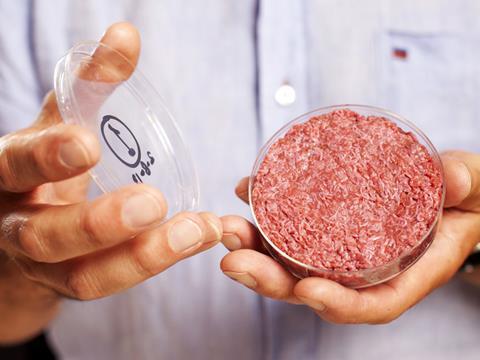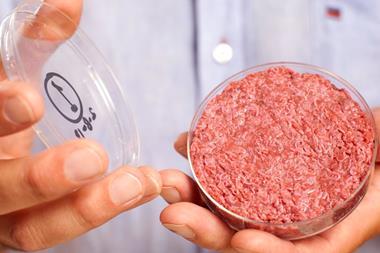Almost a decade since the unveiling of the first lab-grown burger, no business has been able to make it commercially viable. But that’s not stopped the money rolling in
It was seven gruelling months of interviews before Liam (not his real name) was offered the role at a cultured meat startup. That’s not to mention the initial two years between applying and hearing anything at all. By the time he was handed a contract, he was excited at what it could mean. He was, in his own words, looking for people doing “the most pure science” and was impressed at the level of progress the company seemed to be making.
In interviews, the company had insisted it was “far ahead” of the competition when it came scaling up its meat product. The cash was coming in and the core technology was in a great place.
“But within a week of arrival, it was very clear to me that 90% of that stuff they’d told me was untrue,” he says now, having left the company a few months ago. The vast majority of staff had little to no industry experience, he says – often hired straight out of college but handed senior roles to cut costs. “They’d entrust scaling-up devices to some random engineer straight out of academia who just couldn’t do it.”
The problems went far beyond the employees. Despite the cell-based meat process hinging on sterility, the production room had no door, with repurposed sewage water detected in the facilities at one stage, he recalls. He witnessed many runs of the core technological process to make cultured meat. Of those, he says more than 50% resulted in some kind of contamination. It just didn’t work.
Yet outwardly, this same company was making bold statements about how close it was to a fully scalable product. “The idea that they were unaware the technology didn’t work? That isn’t true.”
He is, of course, one man, working in a sector that now spans hundreds of companies, thousands of employees and billions of dollars. In fact, the broader cellular agriculture market has been forecast to reach a value of nearly $100bn by the end of this decade, according to BIS Research.
“This is the beginning of a multi-decade, multitrillion-dollar run of capital”
But his account does involve a major player. It also symbolises a wider clash in the narrative around cultured meat that has surfaced in the past 12 months.
On the one hand, 2021 marked a record year for investment in the sector. By the time Israeli frontrunner Future Meat Technologies shook hands on a funding round worth $347m – five days before Christmas – Q4 funding for the sector was already up 184%. Major players like Aleph Farms, Mosa Meat and Formo had all secured major investments earlier that year.
On the other, there has been a growing trickle of scepticism that this level of investment is misplaced. The technology is so far from being a fully scaled-up commercial product that it may never reach the mass market at all.
So, what’s the truth and how does it differ from the industry hype?
The new frontier
For the uninitiated, cultured meat works a little like this. A few cells are harvested from a live animal. These are cultivated in bioreactors and fed nutrient-dense liquid growth media before (in most cases) being shaped around biological scaffolds until they’re indistinguishable from the burger or chicken breast you’d pick up in your local farm shop.
The exact process will vary from company to company, but the basic steps haven’t changed much since the famous 2013 press conference, when researcher Mark Post bit down into the world’s first lab-grown beefburger – 20,000 thin strips of cultured muscle crafted into a patty at an estimated cost of €250,000. Ever since, the world has been hooked on the prospect of cell-based meat.
In the past decade, the science of cultivated meat has seemingly taken huge strides forward. It’s removed the need for foetal bovine serum (FBS), buckets of which were used to create that first burger in 2013. It’s gone from layers of formless mincemeat to scaffolds that can start to imitate the texture of chicken breasts, bacon, pork belly and even thinly sliced minute steak.

It’s even been able to jump through regulatory hurdles in Singapore – albeit not in the US, EU or UK, where restrictive novel foods regulation is bemoaned by some cultured meat startups as a major stumbling block. In December 2020, San Francisco-based Eat Just announced the Singaporean government had given the green light for it to sell its cultured chicken bites. All of which has made cultured meat an ever more alluring prospect to prospective investors.
As Anthony Chow, co-founder of specialist cellular agriculture investment vehicle Agronomics, sees it: “This is the biggest ESG opportunity of all time, but it also happens to be – in our view – one of the biggest commercial opportunities for the next decade as well. This is a gift,” he says.
“We’re at this inflection point where large institutional investors can see the technology is being de-risked and are starting to deploy very large amounts of capital,” he adds. “These are some of the most sophisticated investors in the world. This is the beginning of a multi-decade, multitrillion-dollar run of capital into an industry that the world absolutely requires.”
Wider market factors are drumming up interest too, points out Paul Cuatrecasas, co-founder of Future Food Finance, a platform targeted at those looking to invest in food tech. “[2021] was a big year across the entire venture capital sector,” he says.
Indeed, investment activity across both Europe and the US more than doubled last year with a sharp rise in food tech as a whole. “Clearly, the cultured meat space benefited from the overall groundswell of venture investing because of interest rates being low and government stimulus during the pandemic, says Cuatrecasas. He echoes Chow in claiming “2021 was the year the promise of cultured meat became more real.”
Not everyone agrees, though. Just as some of those million-dollar deals were being written up from Israel to the Netherlands, so too were a series of high-profile investigative articles that gave voice to some of the industry’s staunchest critics.
Among them was a 10,000-word exposé in US magazine The Counter that landed with a thud and caused “relative immediate alarm”, says Cuatrecasas. Chow is less diplomatic: “It was a hit job on the industry.”

Economically viable?
At the crux of the article’s criticism were the conflicting findings of two techno-economic analyses (TEAs) – a type of report specifically designed to dig into the economic viability of an emerging process.
One was commissioned by the Good Food Institute, a non-profit that backs alternatives to conventional animal products. It concluded that cultured meat could be cost-effective as soon as 2030, with production costs as low as $6.43 per kilogram.
That contrasted sharply with the findings of another, commissioned by grant-making foundation Open Philanthropy. The author, chemical engineer David Humbird, suggested a cost-effective, mainstream product was far from inevitable at all – let alone viable within a decade (see p31).
“Getting ahead of themselves is putting it politely,” says Michele Simon, a public health attorney, food policy expert and founder of the Plant Based Foods Association – and an outspoken critic of cultured meat.
“When this all started being talked about, it was still in the laboratory, the scientific realm and that’s where it pretty much still belongs. It’s not ready for primetime,” she argues. “That’s the part that’s really troubling. That these companies are fuelling these investments and it’s really a lot of talk with very little to show for it. I view it as something that’s in fantasy-land, really.”
Simon is the first to admit she’s not a big fan of the entire concept of cultivated meat. But she does draw a distinction between those she sees as credible scientists working on the tech and those she describes as “propaganda machines” spitting out headline-grabbing predictions every few weeks.
Read more:
-
UK’s cultured meat sector ‘could be worth £2.1bn to economy’
-
3D-printed plant-based meat alternatives launched in UK by Redefine Meat
-
Edible insects, CBD, lab-grown meat: why Brexit is great news for weird foods
-
Nestlé eyes push into cultured meat market
Carlotte Lucas, corporate engagement manager at The Good Food Institute, is far more positive about the prospects. “Ground-breaking work is being done by startups and researchers around the world,” she says. “The confidence of investors is matched by that of the many scientists, life science companies and academics working in this field.”
She points out Eat Just’s cultured product is now available as part of immersive dinners in a few top-end Singapore hotels, setting guests back SG$23 (about £11).
It seemingly makes the case for a commercially viable product. Even this though, comes with questions. The product is a hybrid of around 70% cultured chicken and a plant-based supplement for better structure, while the company is still unable to distribute it on an industrial scale.
The truth is, nobody in the sector has achieved large-scale distribution. Nor has any country other than Singapore granted regulatory approval.
Isha Datar at New Harvest, a research institute focused on cultured meat, is circumspect on how long it will take for that to change. “That’s the million-dollar question. I don’t know. Hybrid products will come sooner than 100% cell-cultured products. But when will you be able to pick up cultured meat at your local Walmart? I think we’re decades away.”
You won’t get quite the same answer if you put the question to one of the big businesses in this space. By the time Future Meat Technologies received its $347m cash injection in December, it said it could create cultivated chicken breasts at $1.70 each (down from $7.50 in February that year), while its growth medium cost just $2 per litre. It hopes to have a facility up and running in the US by 2024.

At Aleph Farms, meanwhile, the plan is to start selling its thin-cut beef steaks to restaurants by the end of this year with the aim of being mass market within the next four to five years, according to CEO Didier Toubia.
The industry is – and always has been – littered with these sorts of confident timelines. Many of which are quietly missed. In November, Upside Foods unveiled its gleaming 53,000 sq ft food production facility in Emeryville, California, with plans to have secured regulatory approval by the end of the year. That date passed with no such announcement.
Neil Dullaghan, a senior researcher at Rethink Priorities who gathered data on various promises for cultured meat, found 89% of the 84 due predictions have been missed. Though “optimistic predictions” might make sense for a nascent sector looking to secure funds and media attention, he is still “somewhat surprised there does not appear to have been any correction in the market in reaction to producers making serially incorrect, overoptimistic predictions.” Far from it, in fact. The money keeps rolling in.
The inner circle
Listen to Simon, and that’s because investors have largely been duped by a mix of charming CEOs and national newspaper headlines. “Part of me wants to feel a little sorry for them,” she says. “They don’t know anything about the science and they’re not talking to the right experts.”
Even those actively investing in this space agree people with deep pockets are leaping in without enough understanding of this deeply technical area. “I’m seeing a lot of people investing in these companies without proper technological due diligence,” says one senior source at an investment fund focused on food tech.
“That’s very foolish. Yes, you can look at a desk and speak to the CEO but if you’re not getting deep into the studies then you might face issues. A lot of these companies have claimed to be a lot closer to product perfection than they are.”
By contrast, their team spoke to around 1,000 different stakeholders and hired highly experienced scientists to pore through every study out there, as well as creating their own, before committing cash.

Others are likely to have done the same. After all, it would be bold to claim the likes of Tyson Foods and ADM Ventures – both of which backed Future Meat Technologies in its latest funding round – are gullible enough to plough millions into a venture without some pretty thorough investigations.
Yet it can be tricky to know what is real in this field. “I think there are companies that have received funding when they shouldn’t have or at the wrong valuation which they didn’t deserve,” says Chow. “There’s a lot of smoke and mirrors. In some of the demonstrations they’re showcasing a product that has less than 1% of animal cells in it. So it’s bullshit.
“I’m not suggesting every single company out there will make it to a multibillion-dollar valuation. There’s a spectrum of quality from terrible to very good within this industry. And at the top end, the CEOs and CSOs, they’re pretty honest and open. At least with us.”
Therein perhaps lies the answer to the simultaneous ramping up and dressing down of the cultured meat sector we saw in the last year.
Because for as much as cultured meat CEOs covet big headlines to keep interest and investment alive, that private investment is also what keeps their processes firmly locked behind lab doors – and speculation about their progress rife. “The nature of the private investment that has fuelled progress so far does mean some findings won’t be made public,” says Lucas.
It’s why studies such as Humbird’s were forced to rely upon publicly available data, drawing insights from adjacent fields. The CE Delft report, conversely, was able to use data supplied by the companies themselves – but it was shared under NDA, making it impossible to scrutinise publicly.
There have been steps toward greater transparency. Dutch company Mosa Meat, for example, has published its approach to eliminating all animal products from its cell culture medium in leading journal Nature. Datar would love to see that transparency go even further. “When cultured meat is happening in private labs, researchers end up duplicating one another’s efforts because they don’t know what other people are working on,” she says. “The fastest way to accelerate the pace of innovation is to publicise scientific findings.”
With such high financial stakes, that isn’t likely to happen any time soon. Without it, there’s a leap of faith – but for GFI and others backing the potential of cultured meat, it’s a leap worth taking.
“Cultivated meat companies and scientists have already challenged many historical assumptions about animal cell culture and we have far from exhausted the creativity of researchers,” says Lucas. “Investors know that the more support they offer to this sector, the more likely its success becomes.”
Exactly how likely that success is, though – and when it will arrive – remains a stab in the dar
Is cultured meat ‘pure science’ or a billion-dollar con?

Almost a decade since the unveiling of the first lab-grown burger, no business has been able to make it commercially viable. But that’s not stopped the money rolling in
 Currently
reading
Currently
reading
Is cultured meat ‘pure science’ or a billion-dollar con?
- 2
- 3

























No comments yet